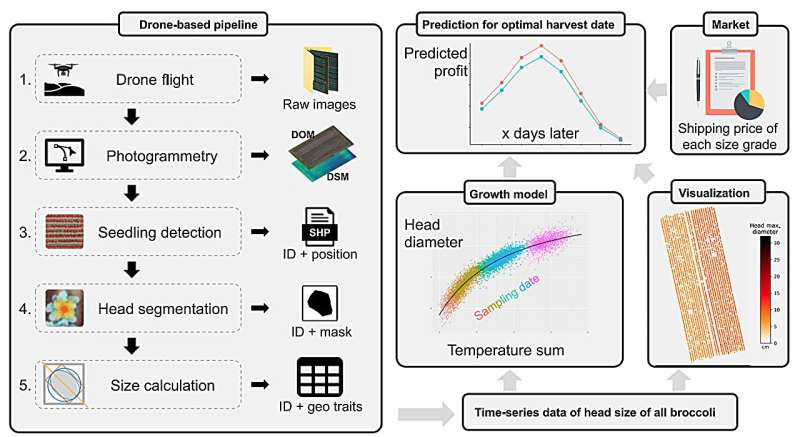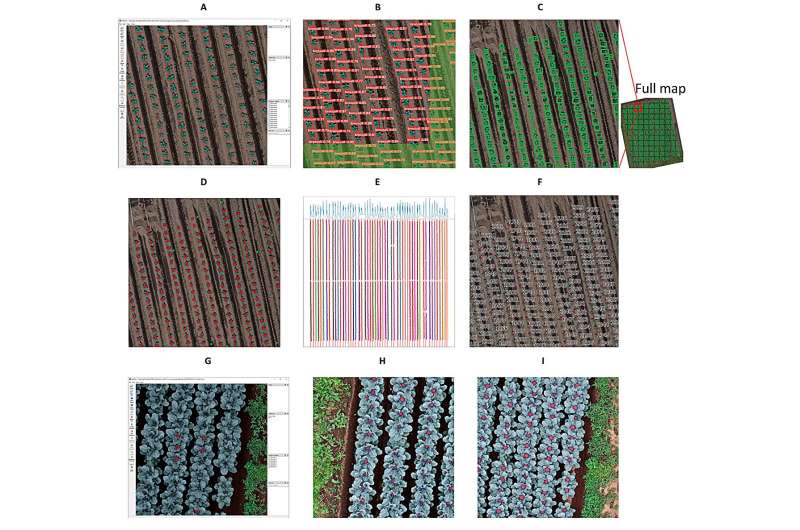This article has been reviewed according to Science X's editorial process and policies. Editors have highlighted the following attributes while ensuring the content's credibility:
fact-checked
trusted source
proofread
AI drones successfully monitor crops to report the ideal time to harvest

For reasons of food security and economic incentive, farmers continuously seek to maximize their marketable crop yields. As plants grow inconsistently, at the time of harvesting, there will inevitably be variations in quality and size of individual crops. Finding the optimal time to harvest is therefore a priority for farmers.
A new approach making heavy use of drones and artificial intelligence demonstrably improves this estimation by carefully and accurately analyzing individual crops to assess their likely growth characteristics.
Some optimistic science fiction stories talk about a post-scarcity future, where human needs are catered for and hard labor is provided by machines. There are some ways in which this vision appears to predict some elements of current technological progress. One such area is in agricultural research, where automation has been making an impact.
For the first time, researchers, including those from the University of Tokyo, have demonstrated a largely automated system to improve crop yields, which can benefit many and may help pave the way for future systems that could one day harvest crops directly. The findings are published in the journal Plant Phenomics.
"The idea is relatively simple, but the design, implementation and execution is extraordinarily complex," said Associate Professor Wei Guo from the Laboratory of Field Phenomics.
"If farmers know the ideal time to harvest crop fields, they can reduce waste, which is good for them, for consumers and the environment. But optimum harvest times are not an easy thing to predict and ideally require detailed knowledge of each plant; such data would be cost and time prohibitive if people were employed to collect it. This is where the drones come in."

Guo has a background in both computer science and agricultural science, so is ideally suited to finding ways cutting-edge hardware and software could aid agriculture. He and his team have demonstrated that some low-cost drones with specialized software can image and analyze young plants—broccoli in the case of this study—and accurately predict their expected growth characteristics. The drones carry out the imaging process multiple times and do so without human interaction, meaning the system requires little in terms of labor costs.
"It might surprise some to know that by harvesting a field as little as a day before or after the optimal time could reduce the potential income of that field for the farmer by 3.7% to as much as 20.4%," said Guo. "But with our system, drones identify and catalog every plant in the field, and their imaging data feeds a model that uses deep learning to produce easy-to-understand visual data for farmers. Given the current relative low costs of drones and computers, a commercial version of this system should be within reach to many farmers."
The main challenge the team faced was in the image analysis and deep learning aspects. Collecting the image data itself is relatively trivial, but given the way plants move in the wind and how the light changes with time and the seasons, the image data contains a lot of variation that machines often find hard to compensate for.
So, when training their system, the team had to invest a huge amount of time labeling various aspects of images the drones might see, in order to help the system learn to correctly identify what it was seeing. The vast data throughput was also challenging—image data was often of the order of trillions of pixels, tens of thousands of times larger than even a high-end smartphone camera.
"I'm inspired to find more ways that plant phenotyping (measuring of plant growth traits) can go from the lab to the field in order to help solve the major problems we face," said Guo.
More information: Haozhou Wang et al, Drone-Based Harvest Data Prediction Can Reduce On-Farm Food Loss and Improve Farmer Income, Plant Phenomics (2023). DOI: 10.34133/plantphenomics.0086
Provided by University of Tokyo





















